
|   |

|   |
 e-mail: leelakaverivenkat@gmail.com Twenty fourth year of Natya Darshan Festival January 10, 2025 Unlike earlier Natya Darshan festivals, this year's celebration, convened by dancer Narthaki Nataraj was built round a theme of the body as a temple, with the motto Connect, Communicate, Elevate, while dealing with a subject. Involving the Pancha Kosha or five layers or sheaths of the human body from Annamaya Kosha, the outermost layer sustained by food, to Pranamaya Kosha, the physical body with life breath, to Manomaya Kosha the vital mental body, to the deeper recesses of mind in Vighyanamaya Kosha, till finally to the total silence and complete harmony of bliss in Anandamaya Kosha, underlines an evolution from gross to subtle body - signifying the route that art also takes with the practitioner - from the physical dancer to the one who communicates from his innermost being. Instead of the comfort of presenting items selected from the common Margam repertoire, here was a need to go through literature in the vernacular languages, to find material suitable to the prescribed theme, and all the participants one saw, had spared no efforts to live up to their allotted theme. 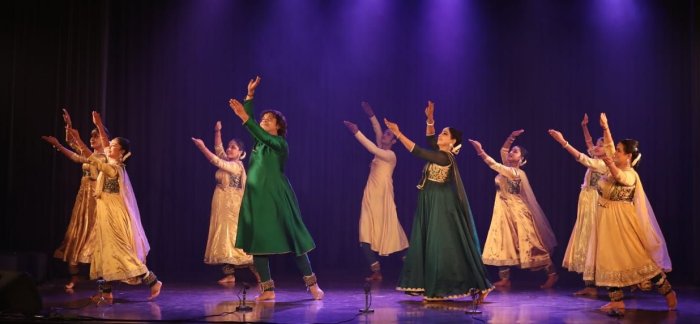 Hari and Chethana with ensemble (Photo: Roy) With so many competing programs in Chennai, my coverage here pertains to what one was able to attend - starting with the Kathak recital by Hari and Chethana of Bangalore. Much travelled as ICCR empaneled dancers, the couple started with the introductory comment that they did not choose Dance but that Dance chose them. Trained under several teachers, their Kathak, while technically sound, does not claim specific gharana credentials. Starting with Poorvarang, with homage paid to the pancha bhoota or five elements and the Ashtadikpalakas or guardian deities in eight directions, the next number Om rendered by the group following a prayer "Kasturi Tilakam" to "Gopala choodamani", went on to abstract Kathak rendered to the musical refrain of the lehera. While the recorded music with Ustad Fayaz Khan's tabla accompaniment could not be faulted, in a straightforward Kathak technique presentation, the absence of live percussion is felt, even as one may perform very correctly, bringing out the khanda and misra laya combinations. 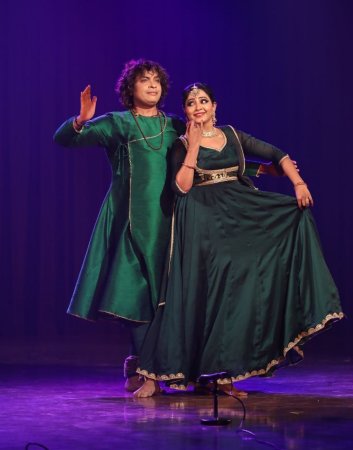 Hari and Chethana (Photo: Roy) The next mimetic offer in Brindavan Saranga, Chaliye Kunjanamo, a composition of Swati Tirunal, with Kavits and Tukras woven in-between interpretative passages, saw the couple dancing together (as Radha and Krishna) expressing joy in the Kunj with the flowing Jamuna waters close by. While the sahitya is without reference to any situation, normally this composition is attributed to Radha trying to cajole and entreat Krishna into joining her in the grove, while nature is draped in a mood meant for an idyllic retreat. Sargam in Darbari Kanada set to 16 beats delighted in Ginti tihai nritta compositions. The performance so far, given the well recorded music, while technically flawless, for this critic, did not rise beyond levels of good technique, and neat presentation involving the physical body and elements of Manomaya Kosha involvement. However it was in the finale of Shiva homage in Nagendra Haaraaya, that one really experienced the bliss or Anandamaya, right from the start with the Ganga Tarangam description of Shiva, and one was treated to a charged Hari lost in Shiva contemplation as Satyam, Shivam and Sundaram. Chethana provided the right support. The Tarana "tana dhirana dheem" proved an ecstatic end, and one felt that the journey of involvement from the outer to the inner body had to an extent, been exemplified. 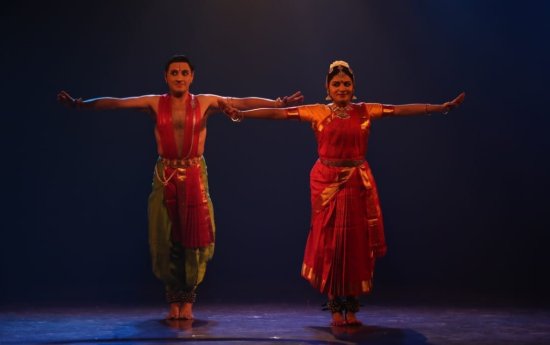 Srikanth and Aswathy (Photo: Roy) The Bharatanatyam couple Aswathy and N Srikanth next took the floor in a presentation, built round the subject of Pranamaya Kosha - and while they performed with the total understanding of stage space between two performers who, over time, have shared the stage, one wonders how far just one aspect of the body could be emphasized in a performance - in total separation from the other koshas. Starting with a Chaturashra Alarippu In Gambheera Nattai set to adi talam, concluding with a text from Tirupugazh Kaithala Nirakani by Arunagirinadhar, the unusual aspect came from Srikanth's choreography - shaped by training under Padma Subrahmanyam - of weaving in motifs and movements attributed to Ganesha, right from the nritta part. The central part of the performance, with the couple alternately performing scenes and finally coming together, was woven round verses from Paraatpara Kanni addressing Shiva as Paraatparame. Conceiving the body as a temple, the devotee beseeches that the God accept his thoughts as incense, his love as turmeric and water to anoint him. Seeking refuge at the feet of the Lord, he asks for the boon of large heartedness, looking upon all living things as sacred. Recalling the saving of Markandeya from the jaws of death, the devotee believes that a real bhakta has nothing to fear. Referring to the many births he has gone through, the devotee wonders when he will be able to attain moksha. Addressing the Lord that though neither well read nor learned, he is a devout follower of Shiva, he ends with a prayer of happiness for all. Paraatpara Kanni, a Ragamalika set to rupakam, portrays the acme of bhakti with the sound of temple bells, and awakening of Pranamaya Kosha through Natya - expressed in this case, through four Jatis of four great Nattuvanars - Kadirvel Swamimalai, S.K. Rajaratnam Pillai, Vazhuvoor Ramiah Pillai and Thanjavur Kittappa Pillai - with narratives on Markandeya and Nandanar, elevating the total surrender of bhakti. The Shaivite emphasis continued in Thiruchanghal based on a Manikkavachagar episode. Asked by Lord Shiva to engage in a debate with the Buddhist monks who have accompanied the Eelam King to Tillai, along with the King's mute daughter (the ultimate aim being of converting Shaiva devotees to Buddhism), Manikkavachagar begins the debate by extolling Shiva - making the God his focal point, and suddenly the mute daughter begins to speak in praise of Shiva! The music for the item, in a traditional tune, had the sahityam part woven in the musical scale of Vedic chanting with three notes - udhatta, arudhanta and svarita, epitomizing that which is Brahman, which is the Nirguna Brahmasmi - the life force lying within, to be awakened only through self-awareness. Based on Vighyanamaya Kosha, the alchemy of emotions, were a couple of duet presentations - from the unending world of human relationships. Jayanthi Subramaniam and daughter Sumitra in a parallel depiction of motherhood depicted in one frame, provided a peep into what one could call, the agony and the ecstasy of situations. Devakiyin Pulambal expresses the agonized feelings of Devaki who, while giving birth to child Krishna, is denied the joys of motherhood in watching him grow - whereas Yashoda without the biological ownership, enjoys the great boon of bringing up the God child, experiencing all the joys of a mother. With Jayanthi as mother and Sumitra as Devaki, elegantly costumed, positioned on two sides of the performance area, the simultaneity in the contrast of denied motherhood against the joys experienced by another, with excellent, well recorded music, made for a powerful performance. Under the same Vighyanamaya section, in a mother and daughter combination featuring Gayatri Kannan and Mahati Kannan, were fast moving snippets of scenes showing the mother worried about finding a groom for the recalcitrant daughter - who brushes off the mother's concern, with the snide remark that her destiny will be, as already ordained by Brahma. Another quick scene from a composition showed Meenakshi, who, having caught a glimpse of Shiva, is confused about her mixed feelings of deep attraction on the one side and of wanting to cry on the other. The last bit based on the well known Subramania Bharatiyar's "Chinnan chiru Kiliye" with the mother advising her child on the courage of conviction, that in any situation one step taken by her will find several doors (feared closed) opening out before her. With both mother and daughter as proven, acclaimed artistes in their own right, one can have little to quarrel about the cameos selected - though one will admit to disappointment that a more formal approach with costumes and well set music (this family is known for) for an occasion like a festival, was not taken. ENTERTAIN OR ELEVATE? The much looked forward to panel discussion by V.P. Dhananjayan, Shanta Dhananjayan, Parveen Sultana and Narthaki Nataraj, on whether Art is meant to entertain or elevate, given the oratorical skills of a moderator like Parveen Sultana, rained Tamil and Hindi poetry, punning on words and syllogisms. Connect, Communicate and Elevate, the motto of the entire festival, is a movement from the base to the top. While Shantha Dhananjayan briefly referred to her love for dance, her joining Kalakshetra and how her marriage to V.P. Dhananjayan provoked societal comments of an unconventional tie with a Malay (that she was), it was marriage to the right partner that had made the art journey so successful. While the artiste would always want his presentation to elevate, sometimes factors in a performance situation stand in the way of achieving the best results, she pointed out. V.P. Dhananjayan very pertinently said that Natya is that rare combination, Apoorva sangam, an embracing term covering physical, mental and spiritual being, relevant to all generations to come. Na tat jnannam, na tat shilpam na sa vidya na saa kaala Na saa yogo na tatkarma naatyasmin yenna drushyate says Bharata in the Natya Sastra, including all the related art forms in the term Natya. The disciple had to keep the three d's in mind - discipline, dedication and devotion. And one can hardly quarrel with the argument that Art while entertaining also elevates. Parveen Sultana argued that Art could not be replaced even by Artificial Intelligence. With her play on words, she pointed out that the term disciple presupposes discipline. In the height of poetic imagery, describing body as a temple and the mouth as the door to the entry of the temple, she mentioned the five sense organs as the illuminating lamps. She dwelt on the mouth and the mind - all involved in the music of speech. While the participants were all eloquent on the role of Art, nobody mentioned that Art performance, is a two way process depending on the onlooker or audience response. To achieve that elevated state of Brahmananda, art needs the 'rasika sabha' of enlightened viewers, not always possible, given the audiences of today - pertaining to several levels of art initiation from the well informed to the totally ignorant - and this can make the artist's trip to that state of inner stillness, more difficult. 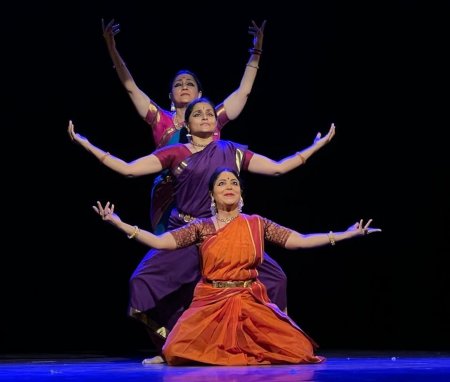 Priya Murle, Padmini Krishnamoorthy and Sreelatha Vinod Dancers Priya Murle and Sreelatha Vinod were allotted the section on Anandamaya Kosha and their interpretation was based on poetry of Andal, Tirumoolar, Abhirama Bhattar and Sadashiva Brahmendra - without any reference to Godhead being Saivite or Vaishnavite. Sreelatha's depiction of bhakti chose to emphasize the sringar/bhakti connect, and for this she started with Tiruppavai with Andal's words "Karpooram Narumo" - the erotic suggestion in the poetry a perfect example of Andal's devotion or bhakti involving a deep element of sensuality. Then came words from Tiruvempavai in which Saivite saint Manikkavachagar in twenty stanzas has penned verses to Shiva sung by young marriageable girls during Margazhi. The dancer also chose a 7th century verse addressed to Shiva from Appar's Tevaram. Priya Murle's evocative abhinaya was strung round poetry in Hindi - starting with Surdas's "Jashoda Hari baalan jhulave" reflecting the ecstasy of mother Yashoda lulling her foster child to sleep followed by an Abhang showing Namdev's state of exhilaration with no idea of the child he has trampled, while chanting "Jesso Vithala Bhakta," concluding with Meera's "Pada Ghunguru re", when Meera untouched by the poisoned drink sent by the Rana, continues her ecstatic dancing in praise of her beloved Krishna. MOHINIATTAM AT ITS BEST Neena Prasad's solo Mohiniattam concert in the evening was one of its kind. With her erudition combining a PhD and post-doctoral degrees, and dance talent enriched with years of collaboration with a fine vocalist like Changanasseri Madhavan Namboothiri, who composes and provides vocal support for her dance, Neena's Mohiniattam firmly rooted in Carnatic music, and committed to the dance form as evolved by Kerala Kalamandalam, sports a range and vitality of its own. She commenced with a Cholkettu in Hamsadhwani set to khandachapu triputa talam composed by Madhavan Namboothiri, and then followed the verse which was relevant to the Margazhi Season with Andal's verses awakening Lord Narayana from his Yoga Nidra in the milky ocean and offering prayers to Lord Varuna to bless mankind with copious rains for the rejuvenation of parched earth, through the waters of flowing rivers - the rhythmic syllables also composed in a way evocative of flowing water and rivers. This was followed by a short item visualizing a scene from the Padmanabaswamy temple, set in ragam Neelambari. What struck one was the clarity of enunciation by the musician, with accompanying talam and drums echoing and catching the tone and atmosphere - with the dance recapturing the scene of the procession - with the chariot flanked by sculpted lions on both sides as it is slowly pulled carrying the supreme One - Marthanda Koti Prabhu Padmanabha Mukundan - with devotees showering flowers as the cavalcade moves on. 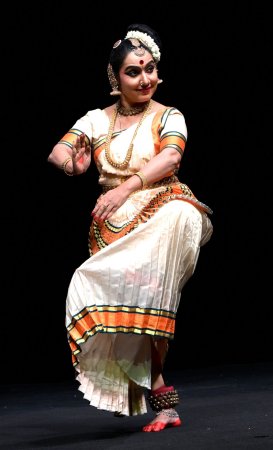 Neena Prasad (Photo: Sivaprasad Thekkile Matam) The Pada Varnam, again with music composition by Madhavan Namboothiri in the ragam Suddha Dhanyasi, for which Neena's Guru Kalamandalam Sugandhi had set the dance, is built round Kandarpa Vichitra Mohini (Vishnu in his manifestation as the beauteous Mohini) even as Devas and demons struggle for supremacy to partake of the ambrosia of immortality churned out of the ocean. Mohini proclaims that she has come only to help in the distribution of the ambrosia. Flitting from one side to the other, Mohini cleverly distributes all the ambrosia among the Devas. Her glamorous tresses make even the proud peacock look inferior, with just one glance at her beauty leaving the demons helpless with unrequited desire. Neena's Mohiniattam, with the sway and grace of her torso in andolika, along with the sweep and conviction of her mukhabhinaya, ensured a captive audience. Following the varnam with the ashtapadi "Keshi mathanamudaram" sung in ragam Charukeshi, the dancer's interpretation communicated with artistic restraint, the prathama samagam episode, with Radha reliving with the sakhi her confidante, her first intimate encounter, and how Krishna through his tender, enrapturing words, had made her forget her extreme shyness. The Tillana in Madhyamavati made for the right end to what was an entrancing hour and a half, enriched by a fine team of musicians with Madhavan Namboothiri's vocal, aided by Ramesh Babu on mridangam, Nandini on the violin and Ashwati providing nattuvangam support. The culmination of this 24th edition of the Natya Darshan featured Leela Samson with her group, comprising dancers from Spanda with students of Jayanti Subramaniam. The program specially curated for this festival, opened with a group presentation of a Mallari in Shuddha Dhanyasi, the music composed by Rajkumar Bharati, on Leela's request. Leela's group visualization is distinctive in that her choreography looks at the same movement executed by interacting dancers facing different directions, and this creates a group geometry which is different. In her group choreography, one never loses a feel of dancers being given individual space, while being part of an ensemble. There seems to be no attempt to create carbon copies of one another, in exemplary uniformity. On the contrary, in an episode like the one built round a poetic and yet, strong ecological message, of the 'Nadi', showing the river flowing with waves, each dancer visualizing this in an individualistic way makes for a totality with the delightful feel of a river where water naturally flows in waves of unequal height. Quick group scenes flashed by - man's abuse of Nature, with an exhortation that we shed our selfishness polluting rivers, and learn to live in harmony with the river, our bounty. Nadi sollum kadai (the stories that flowing rivers tell) had a glimpse of baby Krishna's rescue with river Yamuna holding in check her furiously flowing waters to provide a passage for the God child, and the concluding scene was an endorsement, with man being warned, that given his five senses, he must sense danger in how the environment is being abused - for our survival is linked with a healthy planet. The beauty was that message, dancer individuality, and varying group geometry of movement, could find expression in simultaneity of a group presentation. And right through even the nritta passages in sound and arrangement without jarring, evoked a feel of a Nadi. Next came Leela's quietly eloquent, solo presentation of an ashtapadi from the Gita Govinda, "Madhave makuru manini manamaye" as sung by Late Pandit Jasraj in raga Misra Yaman, wherein the Sakhi as the kalahantarita nayika advises Radha to shed her stubborn pride and contrary responses to Krishna's advances. 'When he is tender you are harsh, when he is loving, you turn away, you are perverse. Why are you condemning your heart to loneliness?' The soulful singing repeating the line Kimiti visheedasi rodashi vikala, vihasati yuvati sabha tava sakala (Why do you cry in despair with all your friends laughing at you) with its interpretation in the dancer's abhinaya was very communicative. Advising Radha not to turn her wounded pride on Madhava who is also proud, the sakhi succeeds in persuading Radha to go to Krishna. Reverting to the group was the next item based on Purandhara Dasa's composition in raga Durga, "Adakhogona ranga, kudi Yamuna teeradalli". 'Let us go and play by the Yamuna riverside Ranga', says the companion to Krishna. The song thereafter reminisces (providing scope for some theatrical scenes in dance) on the historic land that the boys are playing on - this land wherein years ago, Rama broke the bow to win Janaki's hand in a swayamvara, here stood the palace, where in a game of dice, the Pandavas lost their kingdom and were driven to exile. The culmination is a fond hope that Ranga Raya Vithala would come one day to the rescue of the Pandavas - giving them back the lost kingdom! Scenes of swayamvara, dice play were dramatic, without being over acted. The conclusion was a group presentation of a Lalgudi Jayaraman Tillana very well executed. Narthaki Nataraj and her support group of workers can be pleased on a well executed festival effort. 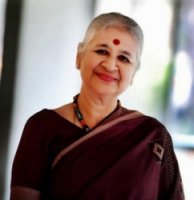 Writing on the dance scene for the last forty years, Leela Venkataraman's incisive comments on performances of all dance forms, participation in dance discussions both in India and abroad, and as a regular contributor to Hindu Friday Review, journals like Sruti and Nartanam, makes her voice respected for its balanced critiquing. She is the author of several books like Indian Classical dance: Tradition in Transition, Classical Dance in India and Indian Classical dance: The Renaissance and Beyond. Post your comments Please provide your name and email id along with your comment. All appropriate comments posted with name and email id in the blog will also be featured in the site. |